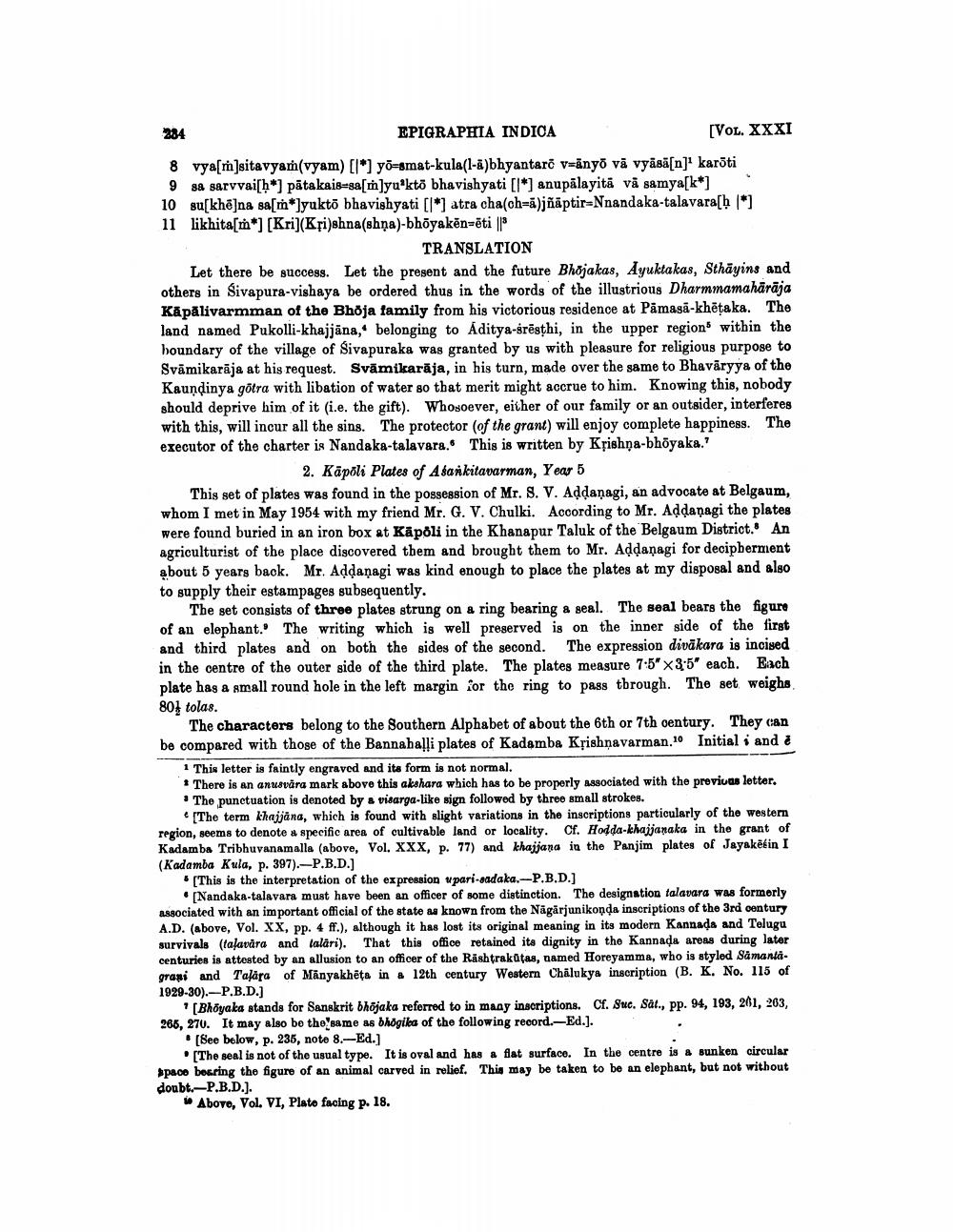________________
234
EPIGRAPHIA INDICA
[VOL. XXXI
8 vya[m]sitavyam(vyam) [*] yo-smat-kula(l-a)bhyantaro v-anyo va vyāsā[n]1 karōti 9 sa sarvvai[*] patakais-sa[m]yu kto bhavishyati [*] anupalayitä va samya[k*] 10 sakhna sathyakto bhavishyati [*] atra cha(ch-4)j&ptir-Naandaka-talavarab (*) 11 likhita[*] [Kri](Krishna(shņa)-bhöyakēnēti p
TRANSLATION
Let there be success. Let the present and the future Bhojakas, Ayuktakas, Sthayins and others in Sivapura-vishaya be ordered thus in the words of the illustrious Dharmmamahārāja Käpälivarmman of the Bhoja family from his victorious residence at Pamasa-khēṭaka. The land named Pukolli-khajjana, belonging to Aditya-sresthi, in the upper regions within the boundary of the village of Sivapuraka was granted by us with pleasure for religious purpose to Svāmikarāja at his request. Svämikarāja, in his turn, made over the same to Bhaväryya of the Kaundinya götra with libation of water so that merit might accrue to him. Knowing this, nobody should deprive him of it (i.e. the gift). Whosoever, either of our family or an outsider, interferes with this, will incur all the sins. The protector (of the grant) will enjoy complete happiness. The executor of the charter is Nandaka-talavara. This is written by Krishna-bhöyaka."
2. Käpoli Plates of Asankitavarman, Year 5
This set of plates was found in the possession of Mr. S. V. Adḍanagi, an advocate at Belgaum, whom I met in May 1954 with my friend Mr. G. V. Chulki. According to Mr. Adḍanagi the plates were found buried in an iron box at Käpöli in the Khanapur Taluk of the Belgaum District. An agriculturist of the place discovered them and brought them to Mr. Adḍanagi for decipherment about 5 years back. Mr. Addanagi was kind enough to place the plates at my disposal and also to supply their estampages subsequently.
The set consists of three plates strung on a ring bearing a seal. The seal bears the figure of an elephant. The writing which is well preserved is on the inner side of the first and third plates and on both the sides of the second. The expression divakara is incised in the centre of the outer side of the third plate. The plates measure 7.5" x 3.5" each. Each plate has a small round hole in the left margin for the ring to pass through. The set weighs 80 tolas.
The characters belong to the Southern Alphabet of about the 6th or 7th century. They can be compared with those of the Bannahalli plates of Kadamba Krishnavarman.10 Initial i and
1 This letter is faintly engraved and its form is not normal.
There is an anusvära mark above this akshara which has to be properly associated with the previous letter. The punctuation is denoted by a visarga-like sign followed by three small strokes.
[The term khajjana, which is found with slight variations in the inscriptions particularly of the western region, seems to denote a specific area of cultivable land or locality. Cf. Hodda-khajjanaka in the grant of Kadamba Tribhuvanamalla (above, Vol. XXX, p. 77) and khajjana in the Panjim plates of Jayakeéin I (Kadamba Kula, p. 397).-P.B.D.]
[This is the interpretation of the expression upari-sadaka.-P.B.D.]
[Nandaka-talavara must have been an officer of some distinction. The designation talavara was formerly associated with an important official of the state as known from the Nägärjunikonda inscriptions of the 3rd century A.D. (above, Vol. XX, pp. 4 ff.), although it has lost its original meaning in its modern Kannada and Telugu survivals (talavara and talari). That this office retained its dignity in the Kannada areas during later centuries is attested by an allusion to an officer of the Rashtrakutas, named Horeyamma, who is styled Samantagrani and Talara of Manyakheta in a 12th century Western Chalukya inscription (B. K. No. 115 of 1929-30).-P.B.D.]
[Bhoyaka stands for Sanskrit bhojaka referred to in many inscriptions. Cf. Suc. Sat., pp. 94, 193, 261, 263, 265, 270. It may also be the same as bhögika of the following record.-Ed.].
[See below, p. 235, note 8.-Ed.]
[The seal is not of the usual type. It is oval and has a flat surface. In the centre is a sunken circular space bearing the figure of an animal carved in relief. This may be taken to be an elephant, but not without doubt.-P.B.D.].
Above, Vol. VI, Plate facing p. 18.




